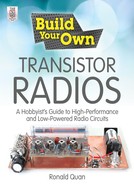Preface
Ever since the invention of amplitude-modulated (AM) radio during the beginning of the twentieth century, there has been a unique interest on the part of hobbyists to build various types of receivers from the crystal radios of that era in the 1900s to the software-defined radios (SDRs) in the twenty-first century. In between the crystal receivers and SDRs are the tuned radio-frequency, regenerative, reflex, and conventional superheterodyne receivers. This book will cover these types of radios from Chapters 5 through 11. Chapter 12 will illustrate two types of front-end circuits for SDRs using analog and sampling methods to generate I and Q signals.
This book actually has two personalities. The first 12 chapters are organized as a do-it-yourself (DIY) book. Starting from Chapter 4, the reader can start building AM test generators for alignment and calibration of AM radios. Beginning from Chapter 5, low-powered tuned radio-frequency (TRF) or tuned radio designs are shown. By Chapter 11, a coil-less superheterodyne radio design is presented.
Throughout Chapters 4 to 12, there are circuit descriptions with some theory. Readers who have some electronics knowledge should find these technical descriptions of the radio circuits useful. Engineering students or engineers should relate even more to Chapters 4 through 11 based on their course work.
The last half of the book from Chapters 13 to 23 relates almost entirely to signals and circuits. These signals and circuits are explained in both an intuitive manner and with high school mathematics. Therefore, if the reader can still remember some basic algebra and trigonometry, the equations shown in these chapters should be understandable. Also, the mathematics behind Chapters 13 to 23 are presented in a step-by-step manner as if the equations or formulas are being written on a white board or chalk board during a lecture. Therefore, this book tries its best not to skip steps in the explanations.
Descriptions on how RF mixers and oscillators work, including large-signal behavior analysis, are generally taught in graduate engineering classes. However, even though modified Bessel functions are mentioned, the explanation of the modified Bessel functions is shown in an intuitive manner via tables and graphs.
For the engineer who has seen transistor amplifier analysis, this book will cover both small- and large-signal behavior, which also includes harmonic and intermodulation distortion.
Therefore, this book can be used as a complement to textbooks for circuits classes and lab courses. When this book was written, the goal was to design as many new or unconventional circuits as possible, along with some conventional examples. Any or some of these circuits can be used for teaching a laboratory electronics class in college and, to some degree, even in high school. For example, Chapter 23 shows how a circuit can be assembled on an index card without soldering any of the parts.
Ronald Quan
